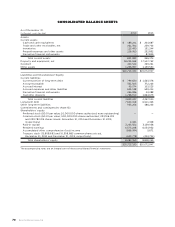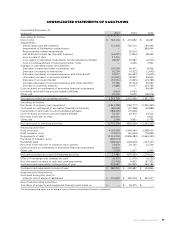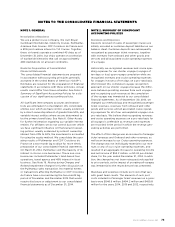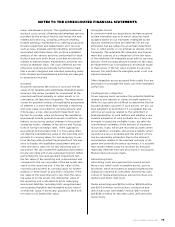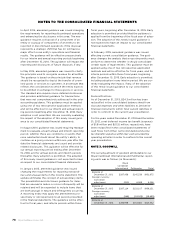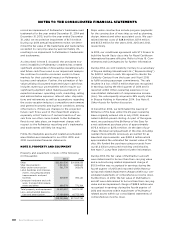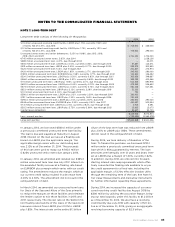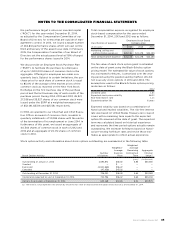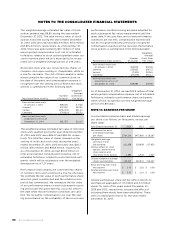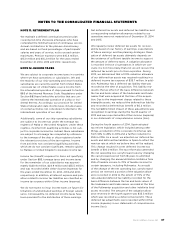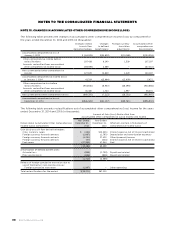Royal Caribbean Cruise Lines 2014 Annual Report Download - page 80
Download and view the complete annual report
Please find page 80 of the 2014 Royal Caribbean Cruise Lines annual report below. You can navigate through the pages in the report by either clicking on the pages listed below, or by using the keyword search tool below to find specific information within the annual report.
Royal Caribbean Cruises Ltd. 79
NOTES TO THE CONSOLIDATED FINANCIAL STATEMENTS
In 2012, we determined the implied fair value of good-
will for the Pullmantur reporting unit was $145.5 mil-
lion and recognized an impairment charge of $319.2
million based on a probability-weighted discounted
cash flow model further discussed below. This impair-
ment charge was recognized in earnings during the
fourth quarter of 2012 and is reported within Impair-
ment of Pullmantur related assets within our consoli-
dated statements of comprehensive income (loss).
During the fourth quarter of 2014, we performed a
qualitative assessment of whether it was more-likely-
than-not that our Royal Caribbean International
reporting unit’s fair value was less than its carrying
amount before applying the two-step goodwill impair-
ment test. The qualitative analysis included assessing
the impact of certain factors such as general economic
conditions, limitations on accessing capital, changes
in forecasted operating results, changes in fuel prices
and fluctuations in foreign exchange rates. Based on
our qualitative assessment, we concluded that it was
more-likely-than-not that the estimated fair value
of the Royal Caribbean International reporting unit
exceeded its carrying value and thus, we did not pro-
ceed to the two-step goodwill impairment test. No
indicators of impairment exist primarily because the
reporting unit’s fair value has consistently exceeded
its carrying value by a significant margin, its financial
performance has been solid in the face of mixed
economic environments and forecasts of operating
results generated by the reporting unit appear suffi-
cient to support its carrying value.
We also performed our annual impairment review
of goodwill for Pullmantur’s reporting unit during the
fourth quarter of 2014. We did not perform a quali-
tative assessment but instead proceeded directly to
the two-step goodwill impairment test. We estimated
the fair value of the Pullmantur reporting unit using
a probability-weighted discounted cash flow model.
The principal assumptions used in the discounted cash
flow model are projected operating results, weighted-
average cost of capital, and terminal value. Signifi-
cantly impacting these assumptions are the transfer
of vessels from our other cruise brands to Pullmantur.
The discounted cash flow model used our 2015 pro-
jected operating results as a base. To that base, we
added future years’ cash flows assuming multiple rev-
enue and expense scenarios that reflect the impact
of different global economic environments beyond
2015 on Pullmantur’s reporting unit. We assigned a
probability to each revenue and expense scenario.
We discounted the projected cash flows using rates
specific to Pullmantur’s reporting unit based on
its weighted-average cost of capital. Based on the
probability-weighted discounted cash flows, we deter-
mined the fair value of the Pullmantur reporting unit
exceeded its carrying value by approximately 52%
resulting in no impairment to Pullmantur’s goodwill.
Pullmantur is a brand targeted primarily at the Spanish,
Portuguese and Latin American markets, with an
increasing focus on Latin America. The persistent
economic instability in these markets has created sig-
nificant uncertainties in forecasting operating results
and future cash flows used in our impairment analyses.
We continue to monitor economic events in these
markets for their potential impact on Pullmantur’s
business and valuation. Further, the estimation of fair
value utilizing discounted expected future cash flows
includes numerous uncertainties which require our
significant judgment when making assumptions of
expected revenues, operating costs, marketing, sell-
ing and administrative expenses, interest rates, ship
additions and retirements as well as assumptions
regarding the cruise vacation industry’s competitive
environment and general economic and business
conditions, among other factors.
If there are changes to the projected future cash
flows used in the impairment analyses, especially in
Net Yields or if certain transfers of vessels from our
other cruise brands to the Pullmantur fleet do not
take place, it is possible that an impairment charge
of Pullmantur’s reporting unit’s goodwill may be
required. Of these factors, the planned transfers of
vessels to the Pullmantur fleet is most significant to
the projected future cash flows. If the transfers do not
occur, we will likely fail step one of the impairment test.
NOTE 4. INTANGIBLE ASSETS
Intangible assets are reported in Other assets in our
consolidated balance sheets and consist of the follow-
ing (in thousands):
Indefinite-life intangible asset—
Pullmantur trademarks and
trade names
Foreign currency translation
adjustment ()
Total
During the fourth quarter of 2014, 2013 and 2012, we
performed the annual impairment review of Pullmantur’s
trademarks and trade names using a discounted cash
flow model and the relief-from-royalty method to
compare the fair value of these indefinite-lived intan-
gible assets to its carrying value. The royalty rate
used is based on comparable royalty agreements in
the tourism and hospitality industry. We used a dis-
count rate comparable to the rate used in valuing the
Pullmantur reporting unit in our goodwill impairment
test. Based on the results of our testing, we did not



